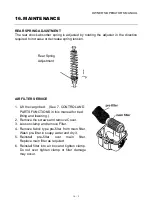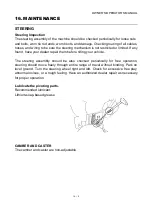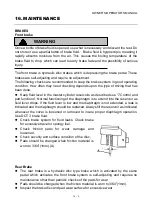
OWNER’S/OPERATOR’S
MANUAL
12. DRIVING YOUR VEHICLE
12- 4
Could cause loss of control or cause the vehicle to overturn.
HOW TO AVOID THE HAZARD
Always check the terrain carefully before you start down any hill. Never go down a hill
at high speed. Avoid going down a hill at an angle that would cause the vehicle to
lean sharply to one side.
Go straight down the hill where possible.
WARNING
POTENTIAL HAZARD
Try to stop the tipping vehicle with your arm or leg.
WHAT CAN HAPPEN
You could be severely injured. You could suffer a crushed hand, arm, leg, or foot.
HOW TO AVOID THE HAZARD
You must keep your arms and legs inside the vehicle until it has stopped moving.
As with any off-road-capable vehicle, there is a risk of tipping over or rollover under
certain conditions. Uneven terrain or slopes which pitch the vehicle sideways, turning
too fast or sharp, or a combination of conditions increase the risk of tipping over.
If you are in a situation where the vehicle is tipping over, do not put your arm or/ and
leg outside the vehicle, do not try to stop tipping with your arm or leg. You could be
severely injured. You could suffer a crushed hand, arm, leg, or foot, if part of your
body is caught underneath the vehicle.
CROSSING THROUGH SHALLOW WATER
If you must cross shallow, slow moving water up to 200mm (8 in) depth, choose your
path carefully to avoid sharp drop-offs, large rocks, or slippery surfaces that could
cause the vehicle to overturn. Never operate through water deeper than 200mm (8 in)
or fast flowing water. Wet brakes may have reduced effectiveness. After leaving the
water, test your brakes. If necessary, apply the brakes several times to let friction dry
out the linings.
NOTE:
After running the vehicle in water, it is critical your machine is serviced as
outlined in the maintenance chart see “16.maintenance”.The following areas need
special attention: engine oil, transmission oil, rear gear case, and all grease fittings.
















































